First Indo-Armenian-French Art & Literary Confluence Concludes in ChennaiChennai, 18...
Read MoreArmenian Church and Armenia Virtual Museum , Chennai – Armenian legacy in India
CogniShift.Org
Mari Poghosyan , Armenian Artist Enterpreneur, Curator and Custodian.
Dr.Prashant Madanmohan , Author,Orthopaedic surgeon,Armenian Cultural Advocate
Armenia Virtual Museum - Chennai, India
Trending # Featured #
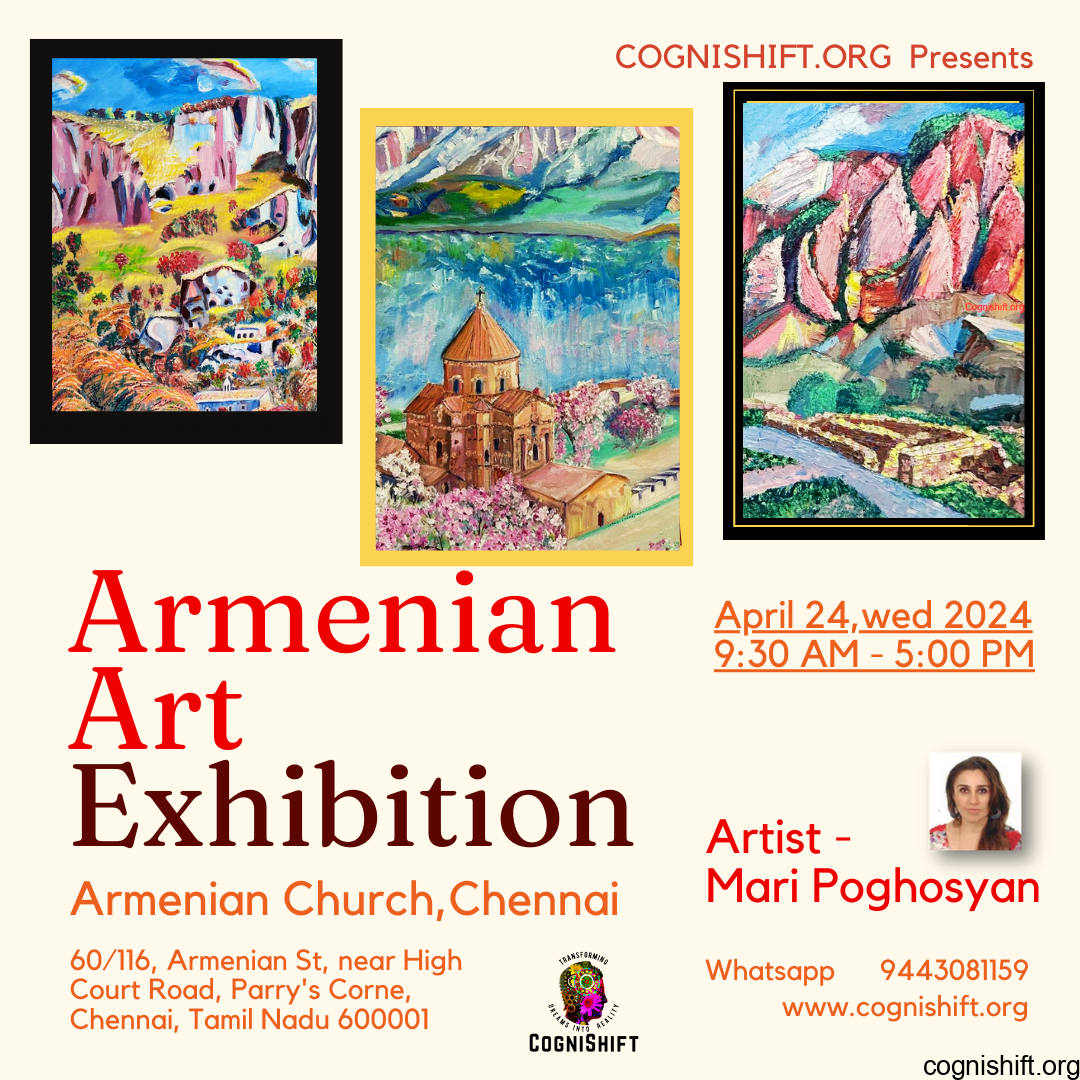
Armenian Art Exhibition 2024 Armenian Church,Chennai
Featuring Armenian Art Exhibition
A brilliant portrayal of Armenian art , architecture and cultural heritage on April 24 , 2024 9:30 am to 5 PM at the Armenian Church, Chennai .
Artist Designer – Mari Poghosyan
Join Facebook Community Group for Photos and Updates
Armenia in India - A Cultural Legacy
“Armenia in India – A Cultural Legacy” unfolds the rich legacy of Armenian cultural imprints in India, weaving through centuries of shared interactions, influences, and historical intersections. Armenian Artist and Enterpreneur Mari Poghosyan, with her profound connections to both nations, curates a journey that traverses through the vibrant Armenian Church at the Armenian street in Chennai, the echoes of the bells in the Armenian Church, and the poignant tales etched on the tombstones of the Armenian cemetery. This space is a confluence where stories, histories, and personal narratives intermingle, offering a comprehensive view into the Armenian-Indian cultural mosaic. Explore, engage, and immerse yourself in a legacy that has seamlessly intertwined itself into the socio-cultural fabric of India, all through the eyes of a dedicated Custodian and Curator of Armenian and Indian Cultural Legacy.
The Armenian Church ,Chennai

The Armenian Church of Chennai located at Armenian Street, Chennai.
The Saint Mary Church in Chennai, also recognized in Armenian as Սուրբ Աստվածածին Եկեղեցի, was originally built in 1712 and underwent a reconstruction in 1772. This church, situated in Chennai, stands as one of the most ancient churches on the Indian subcontinent. Notably, it boasts a six-bell belfry. Also referred to as the Armenian Church of Virgin Mary, it is positioned on Armenian Street, within the George Town neighborhood. Aga Shawmier succeeded Uscan as leader of the Armenian merchant settlement and this church was built (and consecrated in 1772) in his chapel grounds. It has a Shawmier’s room built in his wife’s memory according to a local historian. The church came up on the graves of about 350 Armenians.
Harutyun Shmavonyan, the pioneer publisher, and editor of the inaugural Armenian periodical, “Azdarar,” is buried at this location.
The church boasts the largest bells in the city, each tipping the scales at 200 kg, with the two oldest originating from 1754 and 1778. The altar of the church is a relic from a previous Armenian church situated near the Madras High Court. Additionally, two other bells were donated by Eliazar Shawmier, while the remaining pair date back to 1837. Furthermore, the church complex historically functioned as a burial ground for the city’s Armenian community.
Armenian Freedom Circle - Southern Program and Indian Madras ( now Chennai )
The history of the Armenian community of India is highlighted by the publication of the first Armenian monthly magazine “Azdarar” (“Herald”). It has been issued in Madras in 1794-1796. The activities of Movses Baghramyan and Shahamir Shahamirian are also noteworthy. In 1770–1790, Shahamirian headed the Armenian patriotic circle in Madras, of which Baghramyan had been a member, as well as headed the printing house founded by him in 1771.One of the most pivotal publications to come out of Shahamiryan’s press was Movses Baghramyan’s book “New notebook to call Yordorak.” This book presented a plan for the liberation of Armenia, a vision that was revolutionary for its time.

A picture from around 1790, housed in the British Library in London, depicts members of the Armenian population in what is now known as Chennai, India. In the backdrop, Chennai’s Armenian Church of St. Mariam Astvastsatsin and the fortress of St. Gevorg are visible. Additionally, both Armenian and British trading vessels can be seen moored in the Bay of Bengal.
The Armenian Street in Chennai

Indian Madras, one of the centers of the Armenian diaspora in the 18th century , showing the Armenian street in Madras and Church
Coja Petrus Oscan

When you visit the tranquil Armenian Church of St. Mary, located on Armenian Street, you will find a commemorative plaque that honors the benevolent Armenian , Coja Petrus Oscan , an Armenian merchant who settled in Chennai, India was notably generous with his wealth. He made substantial contributions to the public.He constructed the Marmalong bridge across the Adyar river.He contributed to the construction of St. Rita’s Church in Santhome. A slab on the east wall of the church has the inscription “In the memory of the Armenian nation, 1729.To assist pilgrims traveling to St. Thomas Mount, he funded the creation of a step-way leading up the hillock a A devout individual, Petrus practiced his faith at the Chapel of Our Lady of Miracles in Vipore (Vepery), which he privately owned.Petrus had no children and his wife inherited his wealth. When she died, she left it to charity.
A tastefully designed plaque on the bridge features inscriptions in three languages: Armenian, Persian, and Latin, which reads: “This bridge was built for public interest by Coja Petrus Uscan, belonging to the Armenian nation, AD 1726.” The establishment of the bridge and the stepped pathway to the hill acted as catalysts for the creation of a road, which eventually developed into Mount Road, spurring the southern expansion of the city.
Coja Petrus Uscan who led the Armenian community of Madras from 1723 to 1751 is regarded as the greatest and most famous member of the community.The Armenian merchant community was primarily focused on trade and helping the local government build infrastructure.They contributed to the public infrastructure.The community has almost become extinct, yet its memory survives through Petrus Uscan’s numerous endowments and works of charity.
Constructed at a cost of Rs 1 lakh and bequeathed to the city, the Marmalong Bridge was a testament to Uscan’s commitment to Madras, a city he chose to settle in after arriving in 1724. Not only did he fund the construction of the bridge, but he also ensured resources for its maintenance. Eventually replaced by the Marimalai Adigal Bridge, the original Marmalong Bridge is commemorated with a plaque featuring inscriptions in Persian, Armenian, and Latin. A few years ago, local history aficionados initiated a campaign titled “Retrieve the Uscan Stone” on Facebook, aiming to garner support and attention to preserve the plaque
Marmalong Bridge by Petrus Oscan


Plaque on Marmalong Bridge, Saidapet, Chennai with inscriptions in Persian, Latin and Armenian attributing the construction of the first ever Marmalong Bridge to Coja Petrus Uscan in 1726.
Marmalong bridge, Anna salai built by the Famous Philanthropist Armenian Coja Petrus Oscan – painting by William Hodges, Yale Center for British Art.
The Marmalong Bridge, the earliest bridge spanning the Adyar River, was initially built by Armenian trader Coja Petrus Uscan in 1728 with his own funds.A plaque commemorating Uscan’s contribution to the bridge’s construction is placed at its northern end, adjacent to the Saidapet bus stand.The name of the bridge is derived from the localized English version of the neighboring village of Mambalam.
Harutyun Shmavonyan

Հարություն Շմավոնյան Harutyun Shmavonyan, Gravestone of Shmavonyan, at the Armenian Church Chennai
Harutyun Shmavonyan (Armenian: Հարություն Շմավոնյան), born in Shiraz, Persia, in 1750 and passed away in Madras, India, in 1824, was a revered priest of the Armenian Apostolic Church and is hailed as the pioneer of Armenian journalism due to his establishment of the Armenian journal “Azdarar,” for which he also served as editor. Shmavonyan, who relocated to Madras (present-day Chennai), India, in 1784, dedicated himself to serving as an Armenian priest and later, in 1789, established a second Armenian publishing house.
In October 1794, he launched the Armenian journal “Azdarar” (Armenian: Ազդարար), marking it as the inaugural Armenian periodical ever to be published, thereby cementing his legacy as a trailblazer and the father of Armenian journalism. Although funding for the new publication was secured, the readership was relatively modest. Shmavonyan managed to publish 18 issues of “Azdarar” before its publication ceased in 1796.
Harutyun Shmavonyan passed away in 1824, leaving behind a legacy of pioneering Armenian journalism.
Shahamir Shahamiryan


Shahamir Shahamiryan’s “Vorogayt Parats”
Shahamir Shahamirian, an Armenian writer, philosopher, Armenian freedom movement proponent and prosperous merchant of the 18th century, was born in New Julfa, Iran, and later relocated to India, establishing himself as a wealthy merchant and an active participant in the Armenian community of Madras (now Chennai, India). In 1771, he and his associates established Madras’s first Armenian printing press. Shahamirian, in 1787/88, published “Vorogayt Parats” (“Snare of Glory,” under his son Hakob Shahamirian’s name), which included a proposed constitution for a prospective independent Armenian republic, earning him recognition as the first Armenian constitution’s author.
Born in 1723 in New Julfa, Shahamirian journeyed to Madras during the 1740s. Here, he soon established himself as a leading figure among the Armenians, largely due to his inheritance of his uncle’s fortune. This wealth positioned him as the most affluent Armenian in Madras.
His intellectual pursuits led him to collaborate with key figures like Movses Baghramian. Together with other Armenian intellectuals, they founded the iconic Madras Armenian printing press in 1771. Their printed works stand out as pioneering Armenian expressions of European Enlightenment ideals.
One notable publication was “New Booklet called Exhortation”, championing the revolutionary ideals of constitutional democracy. Shahamirian’s magnum opus, however, was “A Book called Snare of Glory” (Vorogayt Parats). This visionary document is acclaimed as the first-ever Armenian constitution, proposing a parliamentary republic for Armenia with a clear delineation between church and state.
Influence and Vision
Shahamirian’s efforts were not universally lauded. Simeon I of Yerevan, the Armenian Catholicos, perceived Shahamirian’s secular and liberal principles as a threat. The rift escalated when in 1776, the Catholicos demanded the cessation of the Madras press and the destruction of their publications. However, after the Catholicos’ death in 1780, the press resumed its activities, further publishing Shahamirian’s “Booklet of Aim” in 1783, outlining a communal constitution for the Armenian community.
Shahamirian, a visionary, perceived alliances with Heraclius II of Georgia and subsequently the Russian Empire, as key to liberating Armenia. His constitution proposed the possibility of a member from historic Armenian royal dynasties being elected lifelong leader of the republic.
Legacy and Passing
Shahamirian’s demise came in 1797. His substantial legacy included a staggering 52 million gold francs and various properties spanning factories to tobacco plantations in Malacca.
Edward Raphael & Samuel Moorat


The Armenian community notably marked its presence in Madras around the 1660s. “Madras: The Land. The People and Their Governance” by S. Muthiah highlights that the most ancient Armenian tombstone, belonging to Coja David Margar, can be traced back to 1663 and was discovered near Little Mount.Armenians of Madras were the first to discover the sepulchre of St. Thomas upon the Mount in the 16th Century.An Armenian merchant sailor called Thomas Cana, arrived along the Malabar Coast in 780 AD long before the Portugese explorer Vasco da Gama reached India.
While the exact timeline of Armenian settlement remains unrecorded, their dominant role in trade between India and West Asia, as well as with Manila (a Spanish stronghold at the time), is evident. According to “Madras: The Land. The People and Their Governance” by S. Muthiah, the Armenians primarily dealt in commodities like silk, spices, and gems, establishing a trade monopoly in these regions.
Edward Raphael, originating from New Julfa in the Armenian quarter of Iran’s Isfahan province, emerged as a notable figure in the Armenian merchant community in Madras in the latter half of the 18th century. In 1788, he co-founded the Carnatic Bank, Madras’s first joint-stock bank, which persists today as the Bank of Madras.
Additionally, Raphael, alongside his son-in-law and distinguished diamond merchant, Samuel Moorat, established the Collegio Armeno Moorat Raphael in Venice. Both men, known for their enlightenment and ties to the scholarly Mekhitarist order, aimed to offer top-tier education to young Armenians in Europe through their college.Edward Raphael’s son Alexander raphael after his father’s death went to Britain and was the fisrt British-Armenian to serve in the House of commons in the United Kingdom.
Admiralty House by Coja Nazar Jacob

Clive House built by Coja Nazar Jacob originally for himself was the nerve centre of Fort St. George during the British period and continues to serve a bureaucratic purpose even today
The initial renowned Armenian residence in Fort St. George is presently known as Admiralty House, constructed by Coja Nazar Jacob Jan, who reached Madras in 1702.
Aga Nazar Jan paved the way as the inaugural prominent Armenian merchant in Madras, succeeded by notable figures like Coja Petrus Uscan, Aga Shawmier Sultan, and Aga Samuel Moorat. After Samuel Moorat passed away in 1816, his son, Edward Moorat, depleted his substantial inheritance living a luxurious life. His demise marked the beginning of the diminishing Armenian presence in Madras.
Hosanna Arathoon Memorial stone

Hosanna Arathoon , memorial stone in the Luz Church. early 19th century,
Hosanna Arathoon was an Armenian widow of a famous Armenian C. Arathoon who lived in Chennai.
Arathoon Road
John Arathoon was another famous Armenian merchant sharing the same surname who traded in precious stones. He settled in Chennai ( then called Madras) and left his fortune to charity.
There is still the road named Arathoon Road in Royapuram in Chennai where he used to stay.

Arathoon Road , Royapuram
The Armenian Community in Chennai, India today
Presently, three Armenian families reside in Chennai, gathering at the Armenian Church in Chennai to celebrate and uphold their rich heritage.
The Armenian Virtual Museum stands as a testament to the profound and enduring Indian-Armenian cultural legacy, ensuring that the vibrant tapestry of shared histories and collaborative endeavors is not only preserved but also continues to thrive.

News article on Times of India about the Armenian Community in Chennai and Celebration of Armenian Christmas on Jan 5
Armenian Church, Chennai today

Armenian Church Chennai Altar, Armenia Virtual Museum

Armenian Church Bellfry 6 bells Armenia Virtual Museum

Armenian Church Bellfry 6 bells middle 2 Armenia Virtual Museum

Armenian Church Bellfry 6 bells top 2 Armenia Virtual Museum

bell beams Armenia Virtual Museum

Panoramic view of Bell tower Armenia Virtual Museum

Plaque Petrus Oscan Armenian Church Armenia Virtual Museum

Armenian Church bell with Tamil inscription Armenia Virtual Museum

Shahamiryan Tablet Armenia Virtual Museum
About Armenia Virtual Museum by Cognishift.org
About Armenia Virtual Museum by Cognishift.org
Cognishift.Org takes pride in curating and preserving the Armenian Virtual Museum, a digital space that encapsulates and showcases the Armenian cultural and historical imprint in India.
Mari Poghosyan, an Armenian artist and entrepreneur who diligently oversees the digital curation of the Armenian Virtual Museum. She is also the dedicated custodian of the Armenian Virtual Museum Centre at Velachery, Chennai, ensuring that the stories, artifacts, and collective memory of the Armenian-Indian connection continue to be accessible and celebrated by generations to come.
Dr.Prashant Madanmohan is an Orthopaedic Surgeon, Author, Armenian Cultural Advocate, Founder of Cognishift.org
“Mari Poghosyan, an innovative Armenian Artist and Entrepreneur, plays a pivotal role in the digital curation of the Armenian Virtual Museum. As a dedicated custodian of both the museum and the Armenian Virtual Museum Centre at Velachery, Chennai, she seamlessly blends technology and tradition to preserve and showcase the rich Armenian cultural legacy to a global audience, ensuring that the vibrant tales and traditions of Armenia continue to inspire and educate future generations.”
“Dr. Prashant Madanmohan, a distinguished Orthopaedic Surgeon and insightful Author, stands as a fervent advocate for Armenian culture in India. As the visionary Founder of Cognishift.org, he not only bridges the realms of healthcare innovation and literary pursuits but also ardently works towards intertwining the rich cultural tapestries of Armenia and India. His endeavors aim to illuminate the shared histories and vibrant cultural exchanges between these two ancient nations, fostering a deeper understanding and appreciation amongst their peoples.”
References
Prashant Madanmohan (2023-09-09). THE MONK WITH A STETHOSCOPE: A Mesmerizing Tale of Mind Control, Memory Mastery and a New Dimension of Being (1st ed.). CogniShift. ISBN 978-81-950325-2-5.
Dr Prashant Madanmohan; Mari Poghosyan (2023-09-29). Armenian Legacy in India : Chronicles deciphering Indian and Armenian Cultural Legacies
Muthiah, S. (2014). Madras Rediscovered. Chennai: EastWest. p. 383. ISBN 978-93-84030-28-5
Vestiges Of Old Madras (1640-1800) by Love, Henry Davison
Times of India Mari Poghosyan Surb Tsanund Armenian Christmas is here. Times of India Mari Poghosyan Surb Tsanund Armenian Christmas is here.
letters to the editor – editor@cognishift.org
submit your articles on Armenia – armenia@cognishift.org
Latest Events Exhibitions Book releases
The God of Deserted Memories: A Cultural Triumph at Chennai’s Premier Art & Literary Confluence
The God of Deserted Memories: A Cultural Triumph at Chennai’s...
Read MoreArt Exhibition and Book Launch The God Of Deserted Memories
On May 11, 2025, at 4 PM, the iconic Lalit...
Read MoreInterview with Smbat Lputian on CogniShift.org
COGNISHIFT INSIDER, VOL. 1, ISSUE 04/25 Interview with Smbat Lputian...
Read MoreArmenian Art Virtual Museum
Original Art work bringing to life the rich Armenian Art and Culture by Mari Poghosyan – Armenian Artist Enterpreneur

Artsakh-Rug-Armenian-lady Syunik Artsakh Taraz
Artsakh-Rug-Armenian-lady Mari Poghosyan Armenia virtual museum

Pencil sketch SIAMANTO, Mari Poghosyan Armenia virtual museum
Pencil sketch SIAMANTO – great Armenian Siamanto, was an influential Armenian writer, poet and national figure from the late 19th century and early 20th century. Mari Poghosyan Armenia virtual museum
Wiki

Artsakh Winter costume of a woman Syunik Artsakh Taraz
Artsakh Winter costume of a woman Mari Poghosyan Armenia virtual museum

Artsakh jewellery of a woman Syunik Artsakh Taraz
Artsakh jewellery of a woman Mari Poghosyan Armenia virtual museum

Pencil sketch Daniel Varoujan , Mari Poghosyan Armenia virtual museum
Pencil sketch Daniel Varoujan- great Armenian. Daniel Varoujan was an Armenian poet of the early 20th century. Mari Poghosyan Armenia virtual museum
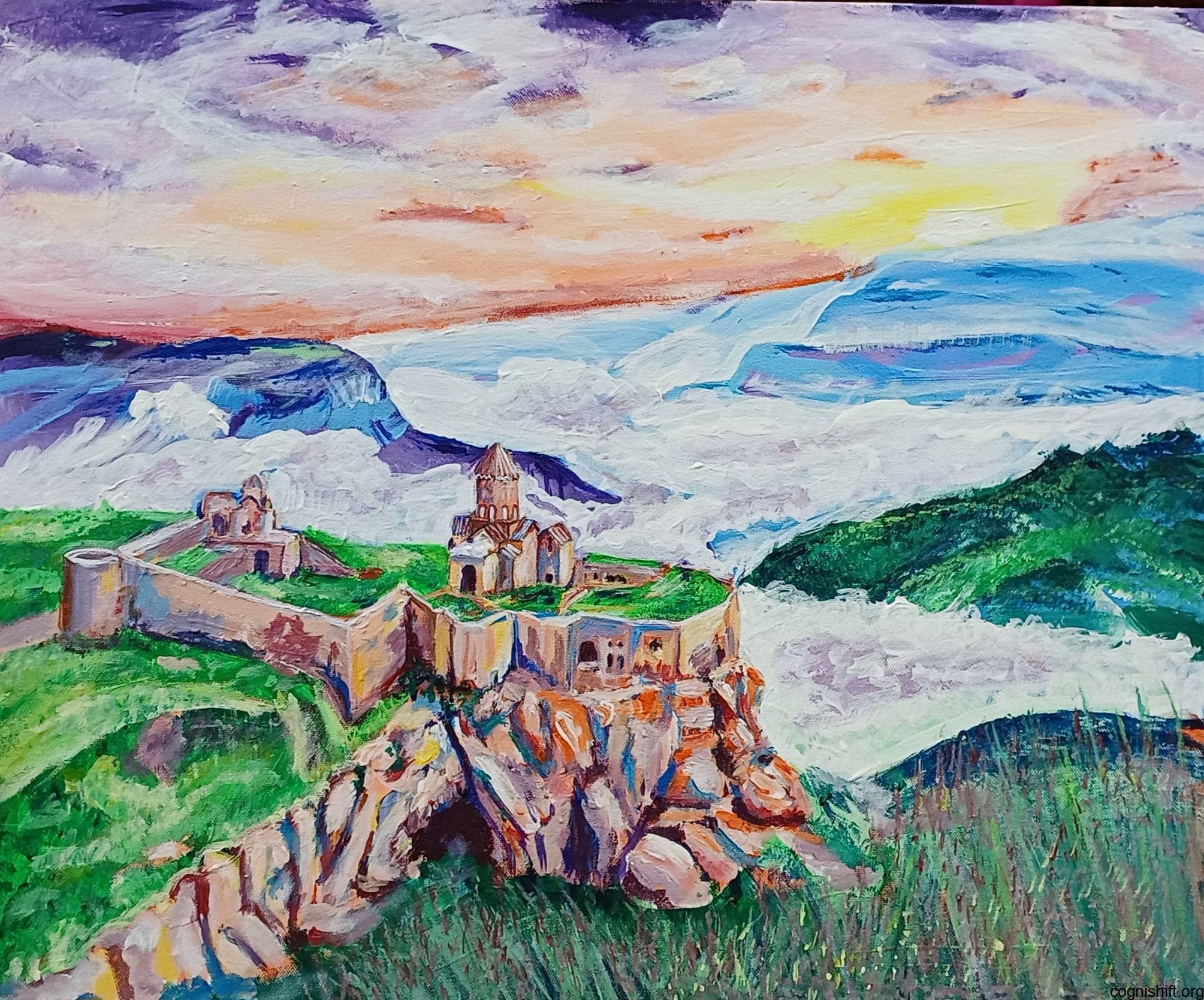
TATEV MONASTERY Acrylic on Canvas painting 50×60cm Original art Mari Poghosyan
TATEV MONASTERY Acrylic on Canvas painting 50×60cm Original art Mari Poghosyan
The Tatev Monastery (Armenian: Տաթևի վանք, romanized: Tat’evi vank’) is a 9th-century Armenian Apostolic Christian monastery located on a large basalt plateau near the village of Tatev in the Syunik Province in southeastern Armenia.
Wiki

Geghard monastery Acrylic on Canvas painting 50×60cm Original art Mari Poghosyan Geghard (Armenian: Գեղարդ, meaning "spear")
Geghard monastery Acrylic on Canvas painting 50×60cm Original art Mari Poghosyan Geghard (Armenian: Գեղարդ, meaning “spear”) is a medieval monastery in the Kotayk province of Armenia, being partially carved out of the adjacent mountain, surrounded by cliffs. It is listed as a UNESCO World Heritage Site with enhanced protection status.
Wiki
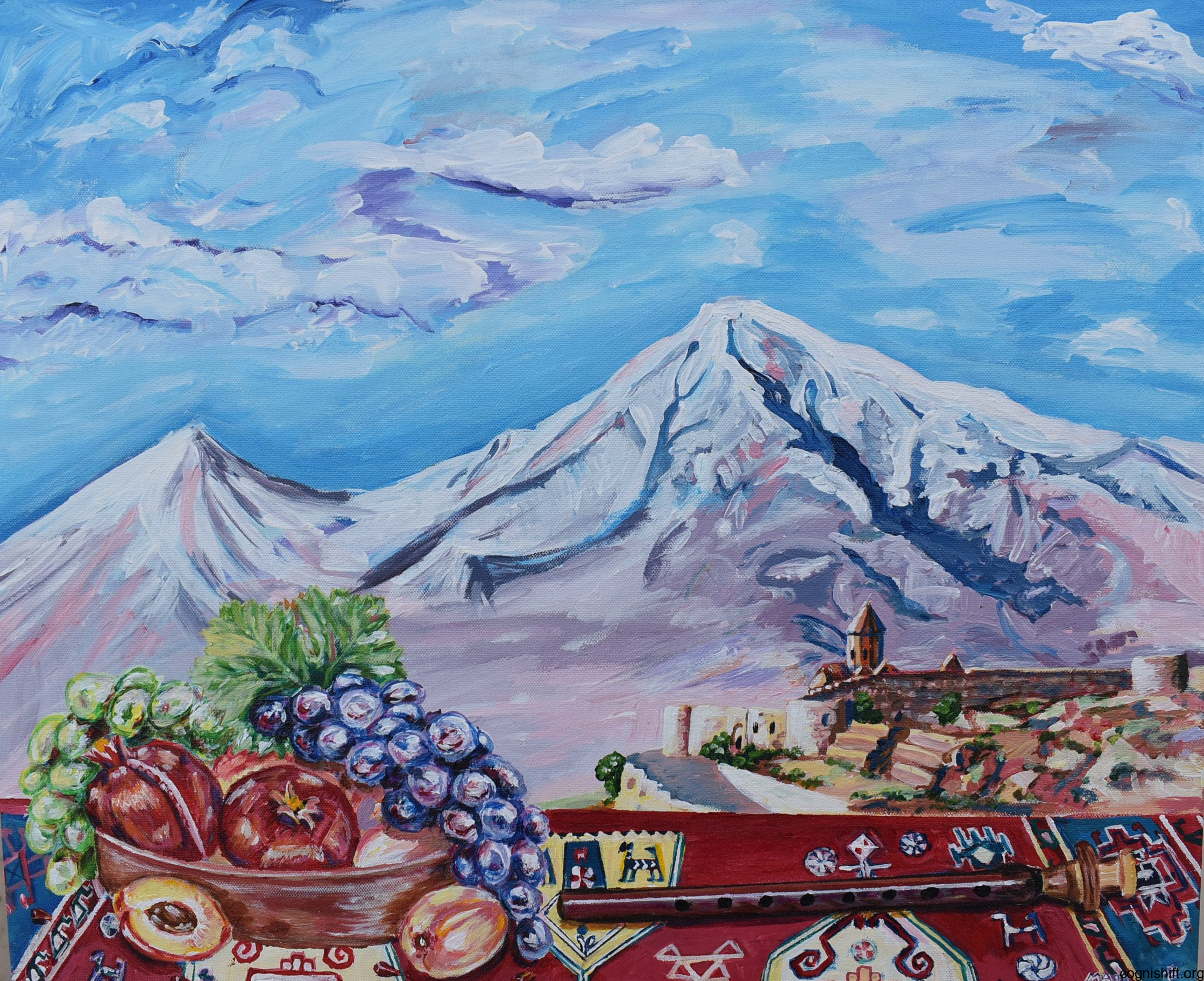
Symphony of Armenia Acrylic on Canvas painting 50×60cm Original art Mari Poghosyan
Symphony of Armenia Acrylic on Canvas painting 50×60cm Original art Mari Poghosyan
The painting shows the Ararat mountain in the background and the Khorvirap Monastery, along with fruits which represent Armenia.Also the traditional Armenian Rug with Armenian motifs and ornaments, Also is featured the DUDUK – traditional Armenian musical instrument.
UNESCO proclaimed the Armenian duduk and its music as a Masterpiece of the Intangible Heritage of Humanity in 2005 and inscribed it in 2008. The duduk (/duːˈduːk/ doo-DOOK; Armenian: դուդուկ IPA: [duˈduk])[1] or tsiranapogh (Armenian: ծիրանափող, meaning “apricot-made wind instrument”), is a double reed woodwind instrument made of apricot wood originating from Armenia. Khor Virap (Armenian: Խոր Վիրապ, lit. ‘deep dungeon’[1]) is an Armenian monastery located in the Ararat Plain in Armenia, near the border with Turkey, about 8 kilometres (5.0 mi) south of Artashat, Ararat Province, within the territory of ancient Artaxata.
Wiki
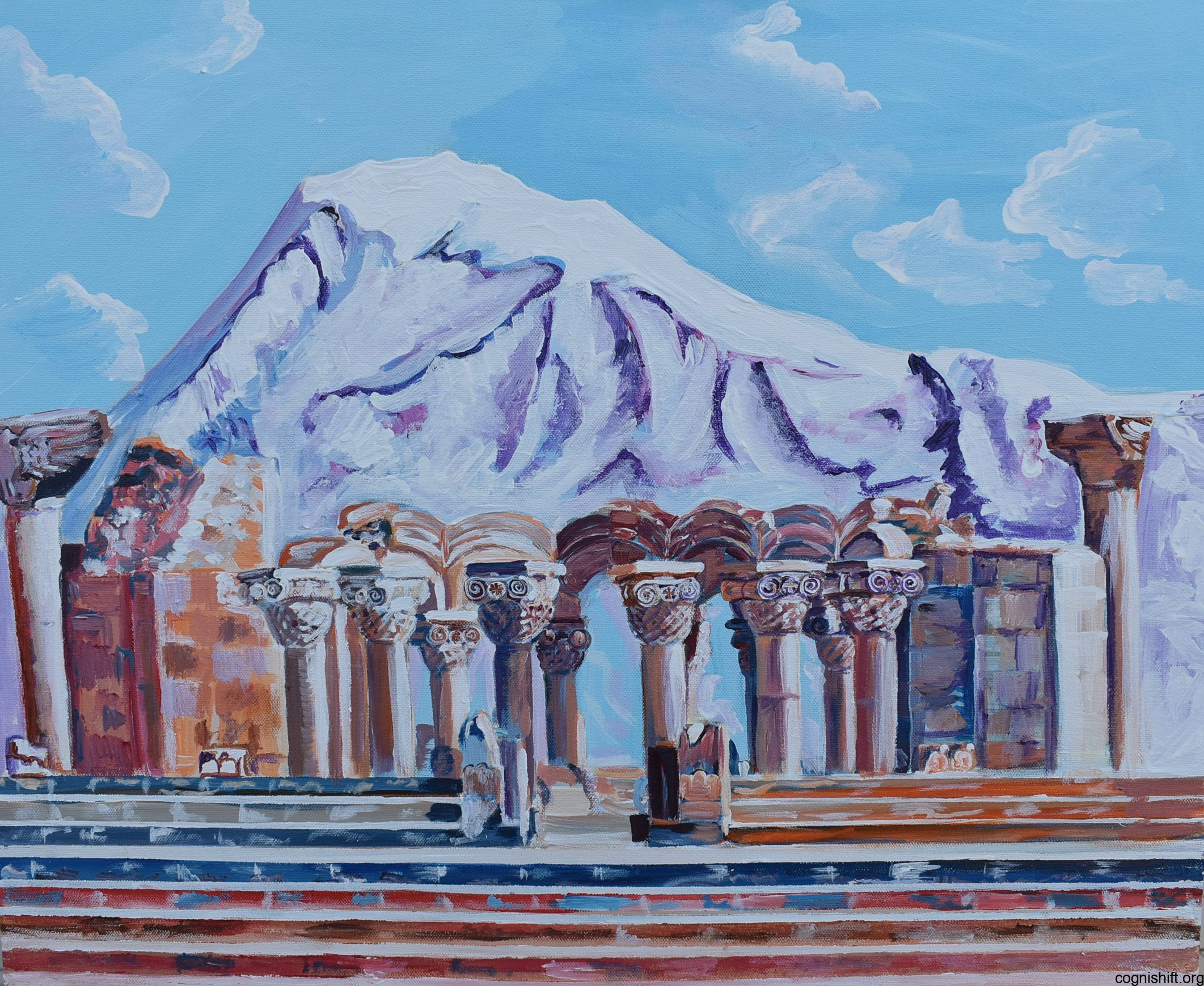
Zvartnots Cathedral Acrylic on Canvas painting 50×60cm Original art Mari Poghosyan
Zvartnots Cathedral
Acrylic on Canvas painting 50×60cm Original art
Mari Poghosyan
Zvartnots Cathedral (Armenian: Զուարթնոց (classical); Զվարթնոց (reformed), sometimes rendered in scholarly works as Zuart’nots’ or Zuart’noc’ ; lit. ‘place of reserection/lifefulness/joyfulness’) is a medieval Armenian cathedral near Vagharshapat (Ejmiatsin), Armenia. Built in the seventh century and now lying in ruins, Zvartnots was noted for its circular exterior structure, unique in medieval Armenian architecture, and a set of interior piers that upheld a multifloor structure crowned with a dome.
Wiki

Moonrise Jan 9 2024 ,Oil painting on canvas, Mari Poghosyan
Moonrise Jan 9 2024 , Oil painting on canvas Mari Poghosyan

Noravank Monastery Jan 25 2024 ,Oil painting on canvas, Mari Poghosyan
Noravank Monastery Jan 25 2024 , Oil painting on canvas Mari Poghosyan
Noravank (Armenian: Նորավանք, lit. ’new monastery’) is a 13th-century Armenian monastery, located 122 km from Yerevan in a narrow gorge made by the Amaghu River, near the town of Yeghegnadzor in Armenia. The gorge is known for its tall, sheer, brick-red cliffs, directly across from the monastery.
Wiki

Վանա լիճ, Աղթամարի Սուրբ Խաչ եկեղեցի, Հայ ճարտարապետության կոթողներից մեկը։ Lake Van, Holy Cross Church of Akhtamar, one of the monuments of Armenian architecture. Oil painting on canvas 98x76 cm Original art Mari Poghosyan
Վանա լիճ, Աղթամարի Սուրբ Խաչ եկեղեցի, Հայ ճարտարապետության կոթողներից մեկը։ Lake Van, Holy Cross Church of Akhtamar, one of the monuments of Armenian architecture. Oil painting on canvas 98×76 cm Original art Mari Poghosyan 12 Feb 2024
The Cathedral of the Holy Cross (Armenian: Սուրբ Խաչ եկեղեցի, romanized: Surp Khachʿ egeghetsʿi, Turkish: Akdamar Kilisesi or Surp Haç Kilisesi) on Aghtamar Island, in Lake Van in eastern Turkey, is a medieval Armenian Apostolic cathedral, built as a palatine church for the kings of Vaspurakan and later serving as the seat of the Catholicosate of Aghtamar.
Wiki

Komitas, "Krunk" Acrylic on Canvas painting 50×60cm Original art Mari Poghosyan
Komitas, “Krunk” Acrylic on Canvas painting 50×60cm Original art Mari Poghosyan
Soghomon Soghomonian,[A] ordained and commonly known as Komitas (Armenian: Կոմիտաս; musicologist, composer, arranger, singer, and choirmaster, who is considered the founder of the Armenian national school of music. “Krunk” has become popular, it has become a symbol of longing for the homeland, hospitality and patriotism. “Krunk” is a lyric and lyric-dramatic poem. The words penned with high poetic art were preserved in the 17th century. manuscript in the press
Wiki

The Garni Temple Acrylic on Canvas painting 50×60cm Original art Mari Poghosyan 27:3:24
The Garni Temple Acrylic on Canvas painting 50×60cm Original art Mari Poghosyan 27:3:24
The Garni Temple is the only standing Greco-Roman colonnaded building in Armenia. Built in the Ionic order, it is located in the village of Garni, in central Armenia, around 30 km (19 mi) east of Yerevan. It is the best-known structure and symbol of pre-Christian Armenia.
Wiki
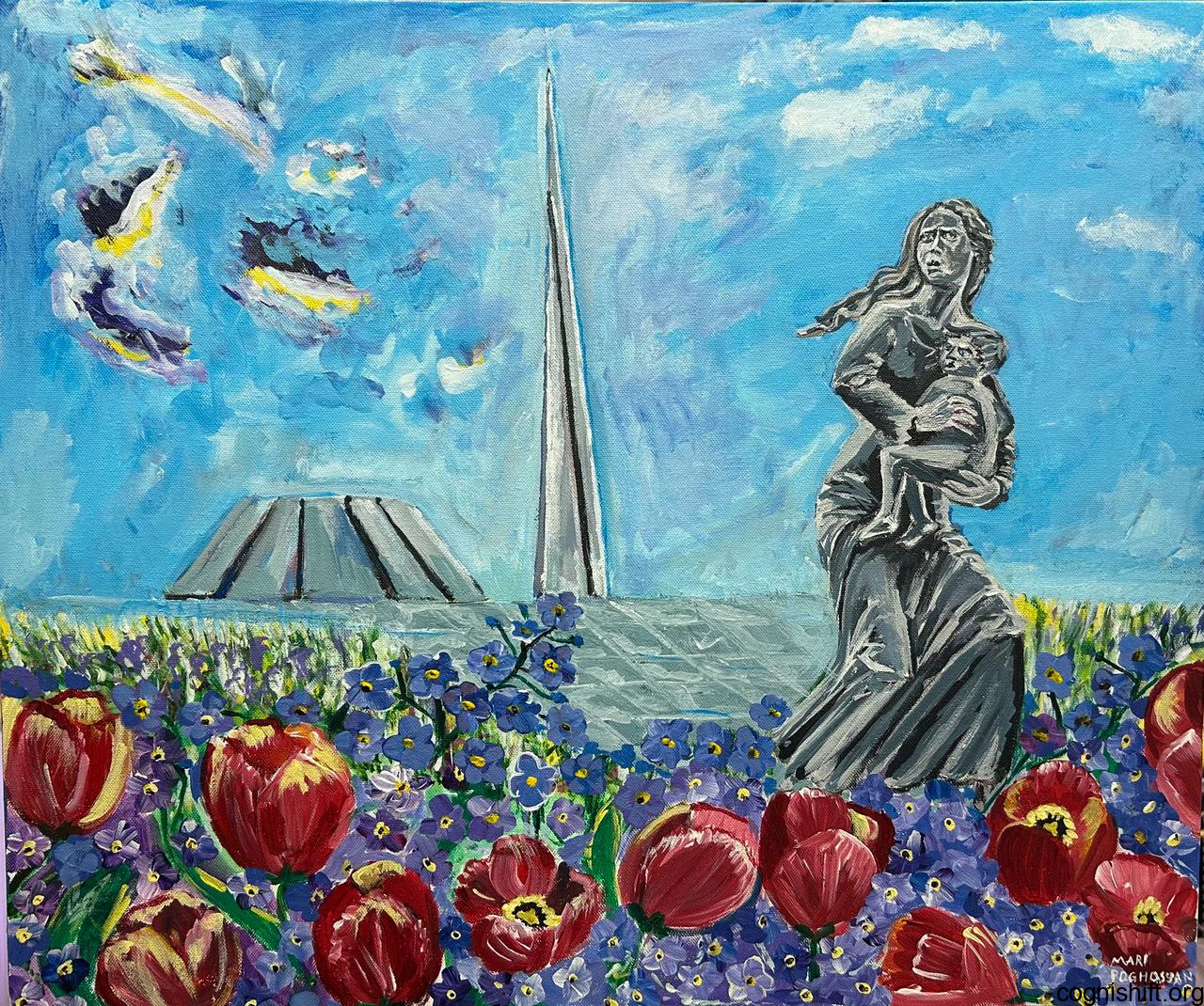
From the Ashes ,Armenian Genocide Memorial Acrylic on Canvas painting 50×60cm Mari Poghosyan 6.02.2024
From the Ashes ,Armenian Genocide Memorial Acrylic on Canvas painting 50×60cm, Mari Poghosyan , 6.02.2024 #art #armenia #ArmenianGenocide
This painting is dedicated to the victims of the Armenian Genocide .
The Armenian Genocide Memorial complex (Armenian: Հայոց ցեղասպանության զոհերի հուշահամալիր, Hayots tseghaspanutyan zoheri hushahamalir, or Ծիծեռնակաբերդ, Tsitsernakaberd) is Armenia‘s official memorial dedicated to the victims of the Armenian genocide, built in 1967 on the hill of Tsitsernakaberd (Armenian: Ծիծեռնակաբերդ) in Yerevan. Every year on 24 April, the Armenian Genocide Remembrance Day, thousands of Armenians gather at the memorial to commemorate the victims of the genocide. The people who gather in Tsiternakaberd lay fresh flowers out of respect for all the people who died in the Armenian genocide. Over the years, from around the world, a wide range of politicians, artists, musicians, athletes, and religious figures have visited the memorial. Also featured in the painting is Mother Arising Out of the Ashes, memorial statue (2002) located in the complex.
Wiki

Amberd Acrylic on Canvas painting 50×60cm Original art Mari Poghosyan Amberd (Armenian: Ամբերդ) is a 10th-century fortress . The name translates to "fortress in the clouds" in Armenian.
Amberd Acrylic on Canvas painting 50×60cm Original art Mari Poghosyan Amberd (Armenian: Ամբերդ) is a 10th-century fortress . The name translates to “fortress in the clouds” in Armenian.
Wiki

Shore Temple Mahabalipuram,Oil painting on canvas Jan 8 2024 , Mari Poghosyan
Shore Temple Mahabalipuram Jan 8 2024 , Oil painting on canvas Mari Poghosyan

Dadivank Armenian Monastery in winter ❄️ ❄️❄️ Original Art , Oil on Canvas, 98 x 69 cm. Mari Poghosyan Jan 31 2024 , Mari Poghosyan
Dadivank Armenian Monastery in winter ![]()
![]()
![]() Original Art , Oil painting on Canvas, 98 x 69 cm. Mari Poghosyan Dadivank (Armenian: Դադիվանք) or Khutavank (Armenian: Խութավանք, lit. ‘monastery on the hill’) is an Armenian Apostolic monastery in the Kalbajar District of Azerbaijan. It was built between the 9th and 13th centuries and is one of the main monastic complexes of medieval Armenia.
Original Art , Oil painting on Canvas, 98 x 69 cm. Mari Poghosyan Dadivank (Armenian: Դադիվանք) or Khutavank (Armenian: Խութավանք, lit. ‘monastery on the hill’) is an Armenian Apostolic monastery in the Kalbajar District of Azerbaijan. It was built between the 9th and 13th centuries and is one of the main monastic complexes of medieval Armenia.
Wiki

Khndzoresk caves, Armenia Oil painting on canvas 98x76 cm Original art Mari Poghosyan
Khndzoresk caves, Armenia Oil painting on canvas 98×76 cm Original art Mari Poghosyan
Khndzoresk (Armenian: Խնձորեսկ, pronounced [χəndzɔˈɾɛsk]) is a village in the Goris Municipality of the Syunik Province in Armenia. The village is located to the east of the Goris–Stepanakert highway, on the steep slopes of Khor Dzor (Deep Gorge), which the village is named after, according to tradition.
Wiki


Noravank Monastery ,Oil painting on canvas, 98 x 69 cm Jan 25 2024 , Mari Poghosyan
Noravank Monastery Jan 25 2024 , Mari Poghosyan

Khndzoresk caves, Armenia Oil painting on canvas 98x76 cm Original art Mari Poghosyan
Khndzoresk caves, Armenia Oil painting on canvas 98×76 cm Original art Mari Poghosyan

Վանա լիճ, Աղթամարի Սուրբ Խաչ եկեղեցի, Հայ ճարտարապետության կոթողներից մեկը։ Lake Van, Holy Cross Church of Akhtamar, one of the monuments of Armenian architecture. Oil painting on canvas 98x76 cm Original art Mari Poghosyan
Վանա լիճ, Աղթամարի Սուրբ Խաչ եկեղեցի, Հայ ճարտարապետության կոթողներից մեկը։ Lake Van, Holy Cross Church of Akhtamar, one of the monuments of Armenian architecture. Oil painting on canvas 98×76 cm Original art Mari Poghosyan 12 Feb 2024

Dadivank Armenian Monastery in winter , Oil painting on Canvas, 98 x 69 cm. Mari Poghosyan Jan 31 2024 , Mari Poghosyan
Dadivank Armenian Monastery in winter ![]()
![]()
![]() Original Art , Oil on Canvas, 98 x 69 cm. Mari Poghosyan
Original Art , Oil on Canvas, 98 x 69 cm. Mari Poghosyan

From the Ashes ,Armenian Genocide Memorial Acrylic on Canvas painting 50×60cm Mari Poghosyan 6.02.2024
From the Ashes ,Armenian Genocide Memorial Acrylic on Canvas painting 50×60cm Mari Poghosyan 6.02.2024 #art #armenia #ArmenianGenocide
Armenian Art Gallery
Original Art paintings by Prof. Dr. Lems Nersisyan – World renowned Armenian Artist Educator and Cultural Ambassador.

աշնանային Oil Painting on Canvas
73 x 60, 1993թ., աշնանային Bring life to your home with personalized and custom artwork

աշնանային Oil Painting on Canvas
73 x 54, 1994թ., աշնանային Bring life to your home with personalized and custom artwork

Սևան Oil Painting on Canvas
73 x 54, 1993թ., Սևան Bring life to your home with personalized and custom artwork

հունիսյան Oil Painting on Canvas
73 x 54, 1993թ., հունիսյան Bring life to your home with personalized and custom artwork


Լեռնային վտակ Oil Painting on Canvas
73 x 54 1999թ Լեռնային վտակ Bring life to your home with personalized and custom artwork

Ընտանիք Oil Painting on Canvas
73 x 54 1999թ Ընտանիք Bring life to your home with personalized and custom artwork

Ջերմուկի ձորը Oil Painting on Canvas
73 x 54 1997թ Ջերմուկի ձորը Bring life to your home with personalized and custom artwork

Մասրենի Oil Painting on Canvas
73 x 54 1995թ Մասրենի Bring life to your home with personalized and custom artwork


ամառային Oil Painting on Canvas
73 x 54 , 2000թ. ամառային Bring life to your home with personalized and custom artwork

Փոքր ջրվեժ Oil Painting on Canvas
73 x 54 1993թ Փոքր ջրվեժ Bring life to your home with personalized and custom artwork

Անտառապահի տնակ Oil Painting on Canvas
70 x 50, 1998թ Անտառապահի տնակ Bring life to your home with personalized and custom artwork

փշերով Oil Painting on Canvas
70 x 50, 1991թ., փշերով Bring life to your home with personalized and custom artwork


փոթորկված Oil Painting on Canvas
70 x 50, 1975թ., փոթորկված Bring life to your home with personalized and custom artwork

զանկգակներ Oil Painting on Canvas
65 x 54, 2003թ զանկգակներ Bring life to your home with personalized and custom artwork

մասրենի Oil Painting on Canvas
65 x 54, 1998թ մասրենի Bring life to your home with personalized and custom artwork

Oil Painting on Canvas
Bring life to your home with personalized and custom artwork












